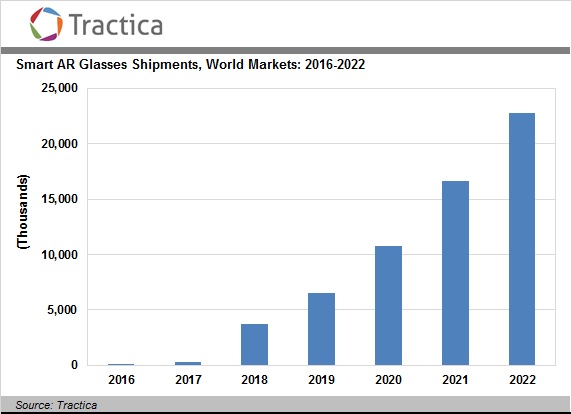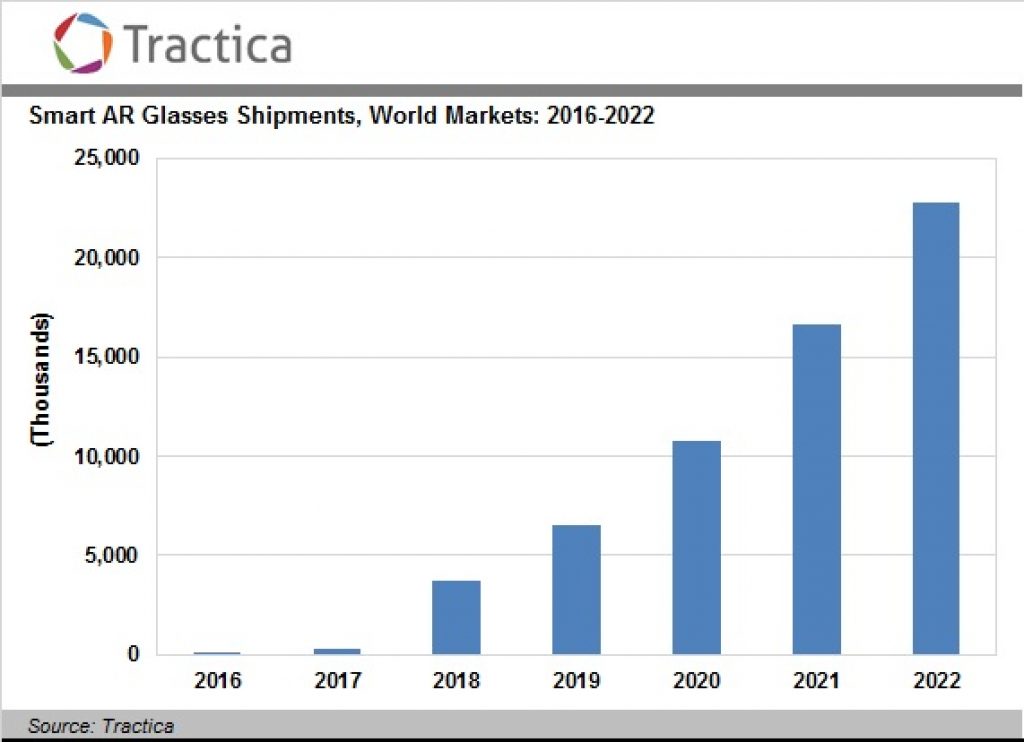This market research report was originally published at Tractica's website. It is reprinted here with the permission of Tractica.
Apple has been in the news recently with suggestions that it has been working on its own smart glasses. Both Bloomberg and the Financial Times have recently featured stories claiming that Apple has internal teams working on smart glasses, with a launch possibly later this year or in 2018. Tech blogger Robert Scoble has also suggested that Apple is further along than we think in terms of launching its own smart glasses, and that it has partnered with optical system manufacturer ZEISS for the project. Tractica’s own analysis and research for our recently published Smart Augmented Reality Glasses report concluded that Apple has a big challenge ahead of it in terms of choosing between two differing technologies and visions in smart glasses: mixed reality (MR) versus assisted reality.
While assisted reality simply overlays digital information on your vision, MR has positional tracking and depth sensors to provide a more immersive experience, enabling interactions with holographic objects. MR headsets are aware of the environment around them, providing a much more immersive experience compared to assisted reality. Assisted reality headsets like Google Glass have not delivered on their promise, and remain niche products that continue to see pilot deployments in industrial and enterprise settings without any meaningful volumes. Slow sales cycles are partly to blame, but most of the assisted reality vendors that we have spoken to blame Google for abandoning the market.
The Mixed Reality Technology Challenges
On the other hand, we are seeing rising interest in Microsoft HoloLens, which is a MR headset. Microsoft launched the HoloLens developer kit in the summer of 2016 and has assembled an impressive list of customers, such as Japan Airlines and Volvo, which are piloting and developing applications for the HoloLens. However, MR headsets have to contend with their own challenges. One of the main technical restrictions facing most MR headsets today is field of view (FOV). This is the window in which one would experience AR or the holograms in the case of a MR headset. Typically, the FOV that is technically possible today is around 30° to 40° per eye, as is the case with the HoloLens, which gives a FOV of around 70° with both eyes combined. Compared to the latest VR headsets like the Oculus Crescent Bay, which provides full immersion, the FOV is more than 100° per eye. Also, from a technology perspective, Microsoft has chosen to go with waveguide combiners, which is a notoriously hard technology to work with. The main problem with waveguide combiners is that they require a lot of precision during manufacturing, and the holographic media used to produce the waveguides are sensitive to temperature, humidity, and pressure. Magic Leap’s current issues are also most likely related to the engineering challenges with waveguide combiners.
However, solutions are emerging in the MR space that might be able to work around the waveguide issue. ODG has chosen to go with traditional combiner technology that does not use waveguides. The Osterhout Design Group (ODG) showcased its latest R8 and R9 MR headsets at CES 2017, which are eyeglasses form factors. ODG has been able to achieve a 50° FOV with the R9’s modular attachments for inside-out tracking and depth sensing. Opting out of waveguides and using organic light-emitting diode (OLED) microdisplays suggests that ODG has chosen to go with the more tried and tested technology option, giving it a slight lead ahead of Microsoft and Magic Leap in both form factor and FOV.
Will Apple Opt for the Simplicity of Assisted Reality?
If Apple is going to go down the MR route, then it must make an engineering decision soon whether to choose waveguide or traditional combiner technology. ODG has taken many years to perfect its combiner technology and, therefore, it would be hard for Apple to replicate that in 1 to 2 years, unless it makes a bid for ODG. Based on the press reporting on Apple, its acquisition of Metaio and the rumored partnership with ZEISS, it seems that it has possibly decided to go down the assisted reality path. Also, Tim Cook has made comments recently around Pokemon Go, which is an assisted reality application. Given Apple’s traditional approach of choosing simplicity over complexity, assisted reality could very well be the path it chooses. However, Tractica believes that to compete in this space, Apple needs to provide a compelling experience, and without 3D depth sensing and positional tracking in assisted reality, it will be unable to compete effectively.

Mixed Reality’s Brighter Future
Tractica also believes that MR has a brighter future than assisted reality, with more than 90% of smart glasses shipments in 2022 being MR glasses. MR headsets will be the primary driver for the smart assisted reality glasses market from 2018 onward, which is when Tractica expects shipments for MR to begin in earnest. Apple’s entry into assisted reality could change things slightly, but in the long run, we still believe that MR is where the future is headed, and Apple will be making a big mistake if it goes down the assisted reality route.


